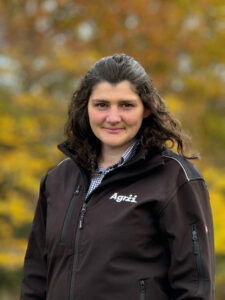This award recognises an outstanding agronomist, who is committed to empowering growers to reach their full potential. The nominee must demonstrate expertise and enthusiasm in the field of agronomy, as well as provide concrete examples of how their guidance has led to tangible improvement in customers’ farm’s performances. Additionally, the nominee should exhibit a strong dedication to ongoing education and professional development within the agricultural sector.
Daniel Lievesley – DJL Agriculture
Daniel describes his approach as “out of the box with a biological approach”. DJL Agriculture embraced regen ag before it started to become mainstream. Transitioning farmers away from chemicals and fertilisers has helped them save significant amounts of money and
delivered broader improvements.
delivered broader improvements.
But it hasn’t been achieved by chance. DJL Agriculture is an early adopter of the latest technology and thinking. A GPS-enabled Wintex soil sampler enables precise soil sampling, ensuring accurate nutrient management plans are put in place. Satellite and drone data adds further insight, ensuring crops are treated according to need as part of an integrated pest management approach.
 Daniel is working with Staffordshire farmers Steve Brandrick and Tim Ellis on fungicide-free wheat trials. Steve had doubts at first. Costello winter wheat was direct-drilled on 18 October into an eight-way cover crop. “The wheat was slow to get moving compared with a crop grown in a conventional programme,” he says.
Daniel is working with Staffordshire farmers Steve Brandrick and Tim Ellis on fungicide-free wheat trials. Steve had doubts at first. Costello winter wheat was direct-drilled on 18 October into an eight-way cover crop. “The wheat was slow to get moving compared with a crop grown in a conventional programme,” he says.As part of the trial, home-brewed compost teas were produced in IBCs. These “biological brews” included beneficial microbes, molasses-based microbe food and trace elements such as Epsom salts. Despite his concerns, Steve held his nerve and the crop came through in the end.
Going fungicide-free is the next step in Tim’s journey. “I’m unsure if you can truly encourage soil biology if you continue to rely on multiple applications of fungicide, which inspired me to undertake the trial,” he adds.
Kathryn Ann Styan – Agrii
Kathryn describes agriculture as a “turbulent” sector, and much of her focus has been protecting her clients from volatility.
She is making good use of the technical advances in ag, with the most recent tool in her armoury being a drone. This is used to scout fields at varying levels, from checking stubble for spraying off, to detecting early disease outbreaks in salad onion crops.
 Salad crops are a speciality. Kathryn is a technical adviser to her Agrii colleagues and she is also working with its R&D department to further develop the use of drones in vegetable crops. She plays an active role in the development of new recruits, last year guiding six candidates through their Basis exams on their first attempt.
Salad crops are a speciality. Kathryn is a technical adviser to her Agrii colleagues and she is also working with its R&D department to further develop the use of drones in vegetable crops. She plays an active role in the development of new recruits, last year guiding six candidates through their Basis exams on their first attempt.She manages an area of 7,000ha, which also includes a broad range of arable and forage crops, and that area is growing as more farmers hear positive reviews of her work.
Using ever-evolving agricultural technology allows her to direct inputs to where they are needed, including variable seed rates and fertiliser applications and remote weather station data to advise on optimal spray timings, especially in the vegetable and potato sector. Despite the weather volatility, most of Kathryn’s clients have seen upturns in their profitability in recent years.
One such client is AM Dowler of Manor Farm, Ilmington. Kathryn has looked after the farm’s agronomy for the past nine years and she is considered a dedicated member of its team. Average yields for wheat and maize have increased, yet costs have been kept sensible.
Chris Taylor – Down to Earth Agronomy
It was a Nuffield scholarship that convinced Chris to set out on his own after working in distribution. He now advises 15 businesses with a specific focus on regenerative farming.
 A holistic approach comes with practicality; Chris hasn’t lost sight of the fact that farming is a business first. Yields have been maintained or improved, while input costs like fertiliser have been reduced. The use of organic manures has seen a fall of 30% in nitrogen applications for some clients, plus reduced lodging and disease risk. This has led to increased client confidence to reduce cultivation practices, leading to further savings in fuel and labour.
A holistic approach comes with practicality; Chris hasn’t lost sight of the fact that farming is a business first. Yields have been maintained or improved, while input costs like fertiliser have been reduced. The use of organic manures has seen a fall of 30% in nitrogen applications for some clients, plus reduced lodging and disease risk. This has led to increased client confidence to reduce cultivation practices, leading to further savings in fuel and labour.Chris recognised that to compete with more established providers, he needed a competitive edge, so he turned to technology. Decisions are made based on data drawn from a range of technologies, from Yara’s N-Sensor to Skippy Scout. It allows him to identify underperforming areas, mapping areas of compaction or weeds and compiling visual reports for clients. It takes the guesswork out of decisions, giving his clients confidence.
One such client is Andrew Shackell. He wanted to change his arable practices and he appointed Chris in 2023. In a short space of time, chemical spend has been cut by 25%. “Chris has provided excellent advice on all aspects, from manure and fertiliser use, chemical rates, cover cropping, integrated livestock grazing to cultivation, all with a keen eye on budget spend.”



